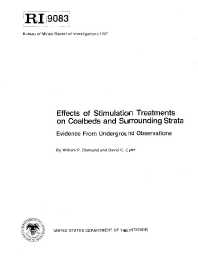Mining Publication: Effects of Stimulation Treatments on Coalbeds and Surrounding Strata: Evidence from Underground Observations
Original creation date: January 1987
Stimulated vertical boreholes are an effective means of removing gas from coalbeds in advance of mining. This Bureau of Mines report examines the coal mine roof damage potential of stimulation treatments. Twenty-two government-sponsored stimulation treatments have been mined through to determine the effects on the coalbed and roof strata. Vertical fractures in the coalbed were discernible for most treatments, and horizontal fractures were present for about half of the stimulations. Sand-propped vertical fractures were usually short in lateral extent. Evidence of stimulation fluid movement could generally be traced beyond the maximum extent of sand- filled fractures when fluorescent paint was added to the treatment fluids. The maximum lateral extent for a sand-filled vertical fracture was 416 ft, and a paint-coated vertical fracture extended 630 ft. Horizontal fractures were generally found within bedding planes, most commonly on top of the coalbed. The maximum lateral extent for a horizontal fracture was 265 ft at a coalbed depth of 630 ft. Horizontal fractures have been found to occur as deep as 1,145 ft. Penetration of strata overlying coalbeds was observed in nearly half of the treatments intercepted. Most of these occurrences have been interpreted to be penetrations into preexisting joints. No roof falls or adverse mining conditions were encountered that could be attributed to the stimulations.
Authors: WP Diamond, DC Oyler
Report of Investigations - January 1987
NIOSHTIC2 Number: 10005572
U.S. Department of the Interior, Bureau of Mines. Report of Investigations 9083, NTIS No. PB87-231858, 1987; :1-48
See Also
- An Analysis of Reservoir Conditions and Responses in Longwall Panel Overburden During Mining and its Effect on Gob Gas Well Performance
- ARBS - Analysis of Roof Bolt Systems - 2.5.02
- Coal Mine Methane: A Review of Capture and Utilization Practices with Benefits to Mining Safety and to Greenhouse Gas Reduction
- Hydraulic Stimulation Increases Degasification Rate of Coalbeds
- Probability of Encountering Coalbed Discontinuities During Vertical and Horizontal Borehole Drilling
- Reinforcing Coal Mine Roof with Polyurethane Injection: 4 Case Studies
- Rotary Drilling Holes in Coalbeds for Degasification
- A Spatial/Spectral Domain Microwave Coal Seam Imaging Sensor-Progress in Signal Processing
- Three Coal Mine Gob Degasification Studies Using Surface Boreholes and a Bleeder System
- Two-Phase Flow in Coalbeds
- Content source: National Institute for Occupational Safety and Health, Mining Program


 ShareCompartir
ShareCompartir
